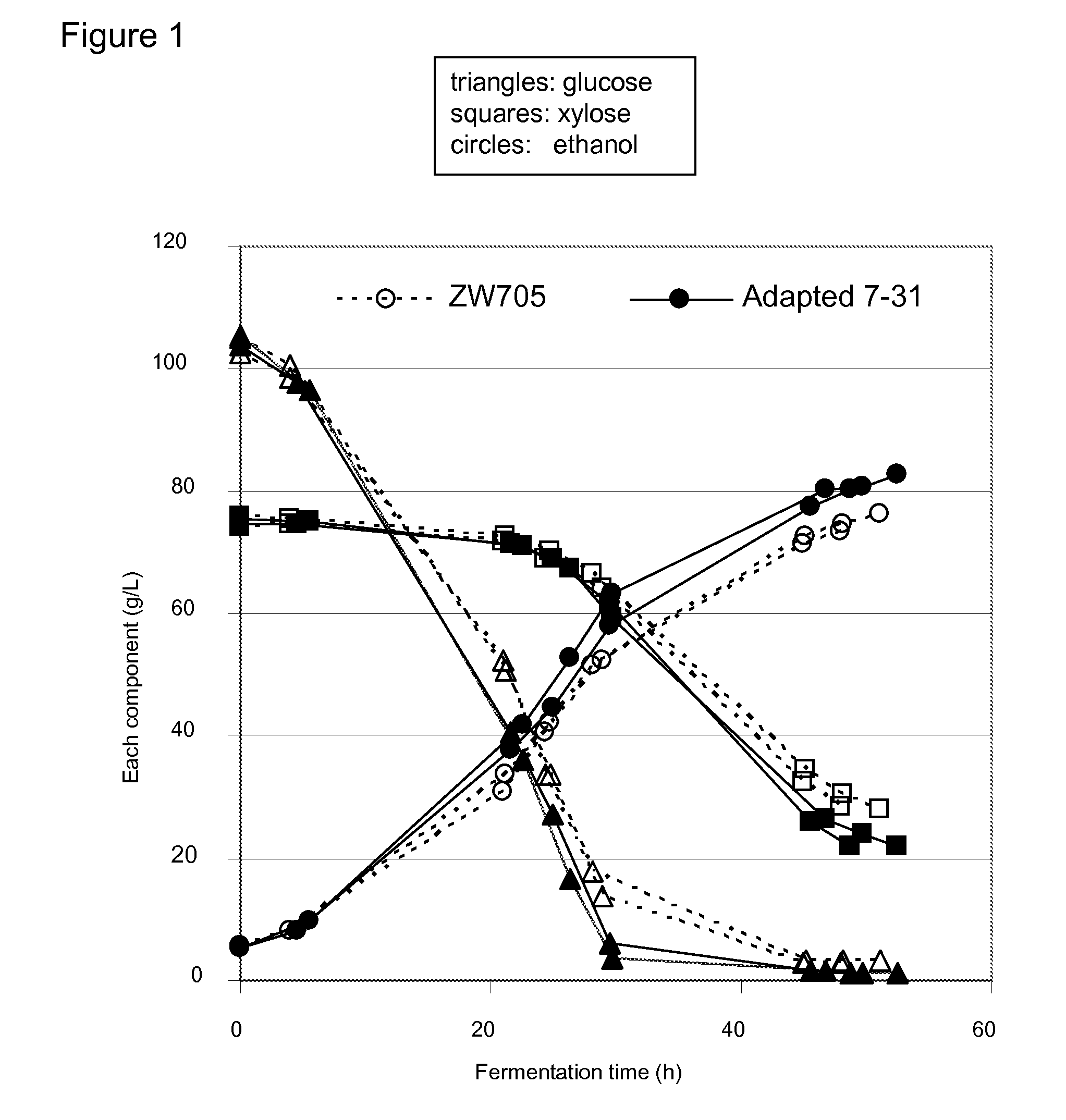Xylose utilizing zymomonas mobilis with improved ethanol production in biomass hydrolysate medium
a technology of biomass hydrolysate and zymomonas, which is applied in the field of microbiology and fermentation, can solve the problems of insufficient growth and ethanol production in biomass-hydrolysate containing medium, and achieve the effect of improving growth and ethanol production
- Summary
- Abstract
- Description
- Claims
- Application Information
AI Technical Summary
Benefits of technology
Problems solved by technology
Method used
Image
Examples
example 1
Adaptation to Corn Cob Hydrolysate Using an Automated, Cell Density Controlled Continuous Culture Apparatus
[0114]The turbidostat described in General Methods was used to adapt Zymomonas mobilis cultures to growth in corn cob hydrolysate medium. A culture of strain ZW705 was grown in the turbidostat described in General Methods to an arbitrary turbidity set point that dictated that the culture use all of the glucose and approximately half of the xylose present in the incoming media to meet the set point cell density at the set dilution rate. Using resting medium that was 50% HYAc / YE and 50% MRM3G6.5X4.5NH4Ac12.3. The turbidostat was run as described in General Methods using as challenge medium HYAc / YE. Cell samples were taken weekly for 6 weeks from the trap chamber.
[0115]After 6 weeks of continuous culture, samples from the weekly saved cell stocks were revived in MRM3G6 and grown to about 1 OD600 in 10 ml static cultures at 33° C. These were used to inoculate 12 ml cultures of HYAc...
example 2
Adaptation to Corn Cob Hydrolysate with Added Ethanol Using an Automated, Cell Density Controlled Continuous Culture Apparatus
[0118]A culture of strain 12-18X-2-36 (described in Example 1) was grown in the turbidostat as described above for strain ZW705 and in General Methods, except that the resting medium was HYAc / YE and the challenge medium was HYAc / YE+9 weight % ethanol. The turbidostat was run for 4 weeks with weekly sampling of the chamber outflow. Frozen cell stocks were made from the outflow samples. Frozen cell stocks were revived in MRM3G6 for testing in 12 ml hydrolysate fermentations under the same conditions as described for the first turbidosat run, but with starting density of about 0.5 OD600. One fermentation was in the same HYAc / YE medium, and another fermentation was in HYAc / YE to which ethanol was added at 30 g per L of medium. Results for both fermentations are shown in Table 3.
TABLE 3Analysis of weekly trubidostat samples grown in 12 ml HYAc / YE or HYAc / YE + 30 g...
example 3
Performance Testing of Hydrolysate Adapted Strains
Seed Fermentation
[0122]Seed fermentation was performed in a 1 L fermenter (Sartorious Stedim BIOSTAT). Sterilized, empty fermenters were filled with filter-sterilized halfYEMaxSM. Seed fermentations were performed at 33° C. and pH 5.5, using unfiltered 4 N NH4OH as the base to control to pH 5.5. Seed fermentations were inoculated with sufficient volume of frozen stock cells that were grown for about 7.5 hr to OD600 of about 2.5, in halfYEMaxSM. Cells were diluted into the 1L fermenter to give a starting OD600 nm of about 0.025. In general, seed fermentations were harvested when ˜120 g / L glucose had been consumed and / or OD600 of about 10 had been reached. The seed fermentations were periodically sampled to monitor growth, and harvested at about 18.5 hr.
Hydrolysate Fermentation
[0123]Hydrolysate fermentation was performed in a 1 L fermentor (Sartorious Stedim BIOSTAT). Sterilized, empty fermentors were filled with 450 ml of corn cob hyd...
PUM
| Property | Measurement | Unit |
|---|---|---|
| Fraction | aaaaa | aaaaa |
| Volume | aaaaa | aaaaa |
| Volume | aaaaa | aaaaa |
Abstract
Description
Claims
Application Information
 Login to View More
Login to View More - R&D
- Intellectual Property
- Life Sciences
- Materials
- Tech Scout
- Unparalleled Data Quality
- Higher Quality Content
- 60% Fewer Hallucinations
Browse by: Latest US Patents, China's latest patents, Technical Efficacy Thesaurus, Application Domain, Technology Topic, Popular Technical Reports.
© 2025 PatSnap. All rights reserved.Legal|Privacy policy|Modern Slavery Act Transparency Statement|Sitemap|About US| Contact US: help@patsnap.com



